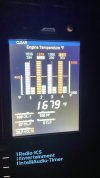Hello folks, I am hoping to get some help here after a frightening flight in a Schweizer 300c with a HIO-360_D1A fuel injected Lycoming engine
I recently installed a JPI EDM-730 to monitor engine conditions. After a few flights CHT are around 300F and EGTs have been good at an average of 1350. Then, the other night (dark) lifting off at 3000ft and a little below freezing, about OAT 28F. I climbed out and leveled off and reduced power to around 20" Manifold pressure. I looked over at the JPI and saw EGTs through the roof! average around 1650 and one cylinder peaked at 1730. I reduced the power to descend and land but had nowhere to land, so I pulled power up to 26" to climb out. With a careful eye on the JPI I saw the EGTs lower to a reasonable number like 1500F. I kept climbing and the EGTs remained about 1500F. I climbed out and flew to 7500ft to return to base. I noticed when I reduced power the EGT climbed significantly. Descending to land I had super high EGTs again. Well, I made it but did not enjoy that flight as those EGTs are frightening. The next day I went for a test flight. Lifting off at 3000ft but this time at an OAT temp of 65F. The EGTs were stable at 1350. Everything looked better. But when reducing power EGT climbed, not dangerously but enough to show a trend. EGT at lower power of 18" went to 1500F.
Any ideas?
I recently installed a JPI EDM-730 to monitor engine conditions. After a few flights CHT are around 300F and EGTs have been good at an average of 1350. Then, the other night (dark) lifting off at 3000ft and a little below freezing, about OAT 28F. I climbed out and leveled off and reduced power to around 20" Manifold pressure. I looked over at the JPI and saw EGTs through the roof! average around 1650 and one cylinder peaked at 1730. I reduced the power to descend and land but had nowhere to land, so I pulled power up to 26" to climb out. With a careful eye on the JPI I saw the EGTs lower to a reasonable number like 1500F. I kept climbing and the EGTs remained about 1500F. I climbed out and flew to 7500ft to return to base. I noticed when I reduced power the EGT climbed significantly. Descending to land I had super high EGTs again. Well, I made it but did not enjoy that flight as those EGTs are frightening. The next day I went for a test flight. Lifting off at 3000ft but this time at an OAT temp of 65F. The EGTs were stable at 1350. Everything looked better. But when reducing power EGT climbed, not dangerously but enough to show a trend. EGT at lower power of 18" went to 1500F.
Any ideas?

